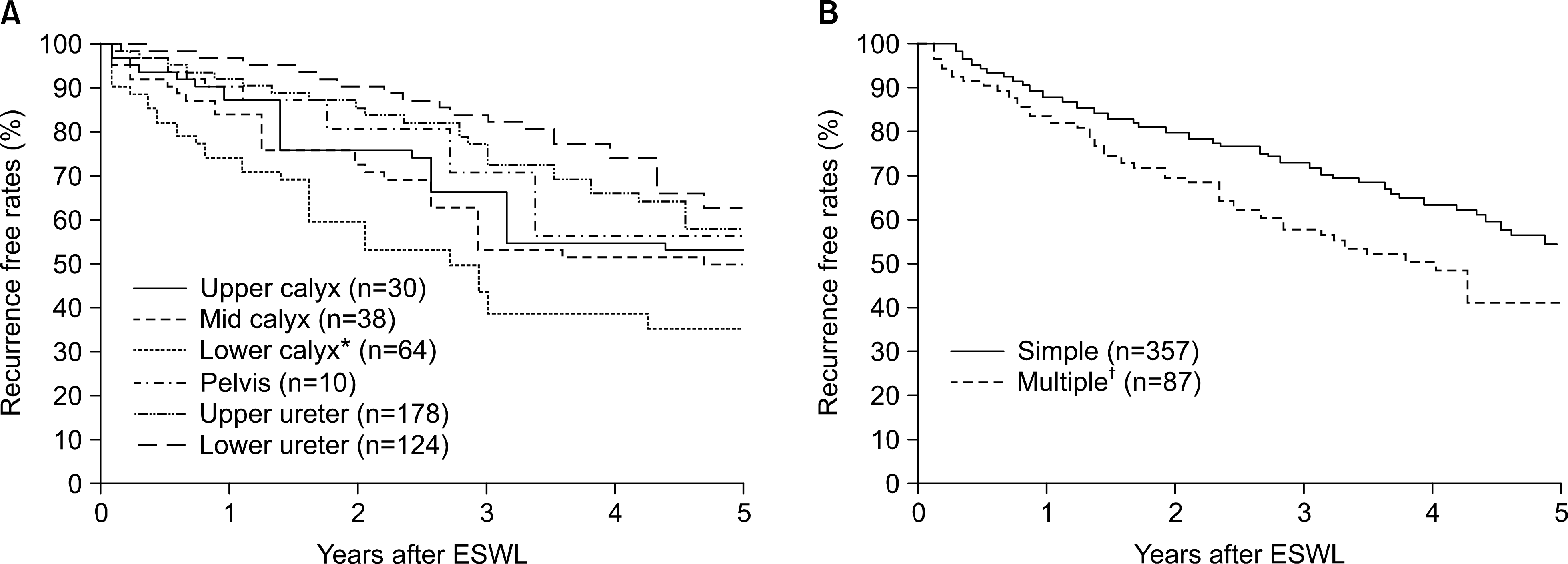Abstract
Purpose:
After treatment, urinary stones are known to have high recurrence rates. Therefore, the recurrence rates and risk factors for recurrence after successful extracorporeal shock wave lithotripsy (ESWL) were investigated to help in the decisions making for the treatment of patients with urinary stones.
Materials and Methods:
Between January 1999 and December 2000, 415 patients (444 renal units), treated by ESWL due to urinary stones, were followed up for 5 years using either KUB or sonography. Treatment success was defined as complete passage of the stone or insignificant stone fragments, less than 3mm in diameter, remaining. The stone recurrence rates were calculated using the Kaplan-Meier method. The possible risk factors for recurrence, such as sex, age, familial history of urinary stones, abnormal metabolic finding, pyuria after ESWL, stone location, size and multiplicity, were analyzed.
Results:
The overall number of recurrent stones was 82 in 444 renal units (18.5%). Using the Kaplan-Meier method, the recurrence rates were determined as 7.5, 17.8, 34.8, 39.8 and 45.8%, respectively, for each year upto 5 years. Among the many possible risk factors for a recurrence, the stone location (especially lower calyx) and multiplicity were found to be significant (p=0.042, p=0.009).
Go to : 
REFERENCES
1.Chaussy C., Brendel W., Schmit E. Extracorporeally induced destruction of kidney stones by shock waves. Lancet. 1980. 2:1265–8.

2.Yu CC., Lee YH., Huang JK., Chen MT., Chen KK., Lin AT, et al. Long-term stone regrowth and recurrence rates after extracorporeal shock wave lithotripsy. Br J Urol. 1993. 72:688–91.

3.Drash GW., Dretler S., Fair W., Finalayson G., Gillenwater J., Griffith D, et al. Report of the United States cooperative study of extracorporeal shock wave lithotripsy. J Urol. 1986. 135:1127–33.
4.Yokoyama M., Shoji F., Kanemura M., Kitahara K., Itakura H., Fujito S, et al. Long term results of ESWL: stone recurrence and fate of residual fragments. Jap J Endourol. 1990. 3:187.
5.Kamihira Ο., Ono Y., Katoh N., Yamada S., Mizutani K., Ohshima S. Long-term stone recurrence rate after extracorporeal shock lithotripsy. J Urol. 1996. 156:1267–71.
6.Denstedt JD., dayman RV., Picus DD. Comparison of endoscopic and radiological residual fragment rate following percutaneous nephrolithotripsy. J Urol. 1991. 145:703–5.

7.Osman MM., Alfano Y., Kamp S., Haecker A., Aiken P., Michel MS, et al. 5-year-follow-up of patients with clinically insignificant residual fragments after extracorporeal shockwave lithotripsy. Eur Urol. 2005. 47:860–4.

8.Ljunghall S., Danielson BG. A prospective study of renal stone recurrences. Br J Urol. 1984. 56:122–4.

9.Trinchieri A., Ostini F., Nespoli R., Rovera F., Montanari E., Zanetti G. A prospective study of recurrence rate and risk factors for recurrence after a first renal stone. J Urol. 1999. 162:27–30.

10.Ahlstrand C., Tiselius HG. Recurrences during a 10-year follow-up after first renal stone episode. Urol Res. 1990. 18:397–9.

11.Sampaio FJ., D' Anunciacao AL., Silva EC. Comparative follow-up of patients widi acute and obtuse infundibulumpelvic angle submitted to extracorporeal shockwave lidiotripsy for lower caliceal stones: preliminary report and proposed study design. J Endourol. 1997. 11:157–61.
Go to : 
 | Fig. 1.(A) Stone location versus recurrence free rates. (B) Multiplicity versus recurrence free rates. ESWL: extracorporeal shock wave lithotripsy. statistically significant difference (p=0.042), f statistically significant difference (p=0.009). |
Table 1A.
The characteristics of the 415 patients treated with ESWL
Table 1B.
The characteristics of the original stones




 PDF
PDF ePub
ePub Citation
Citation Print
Print


 XML Download
XML Download